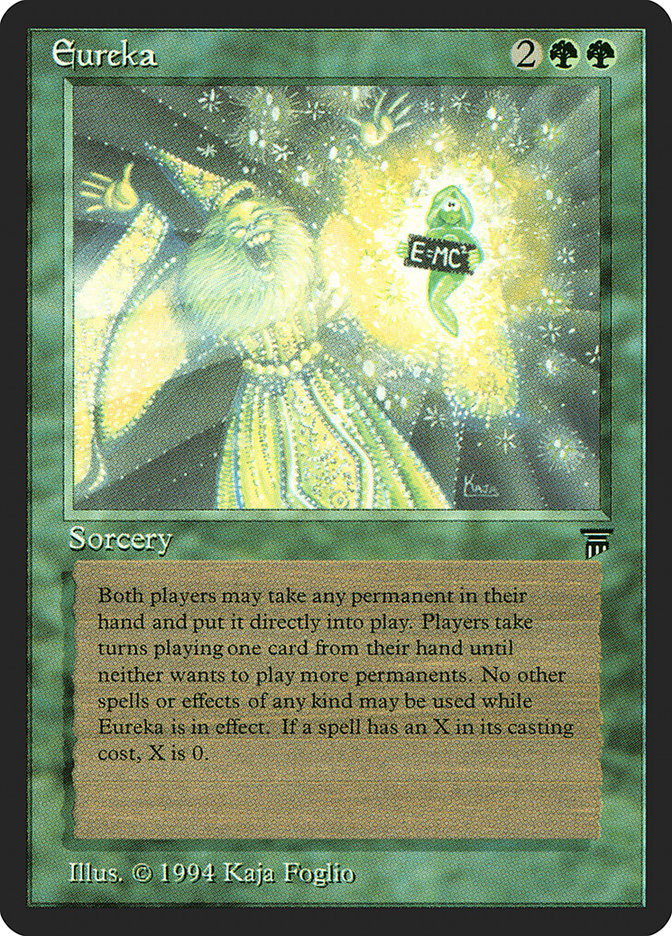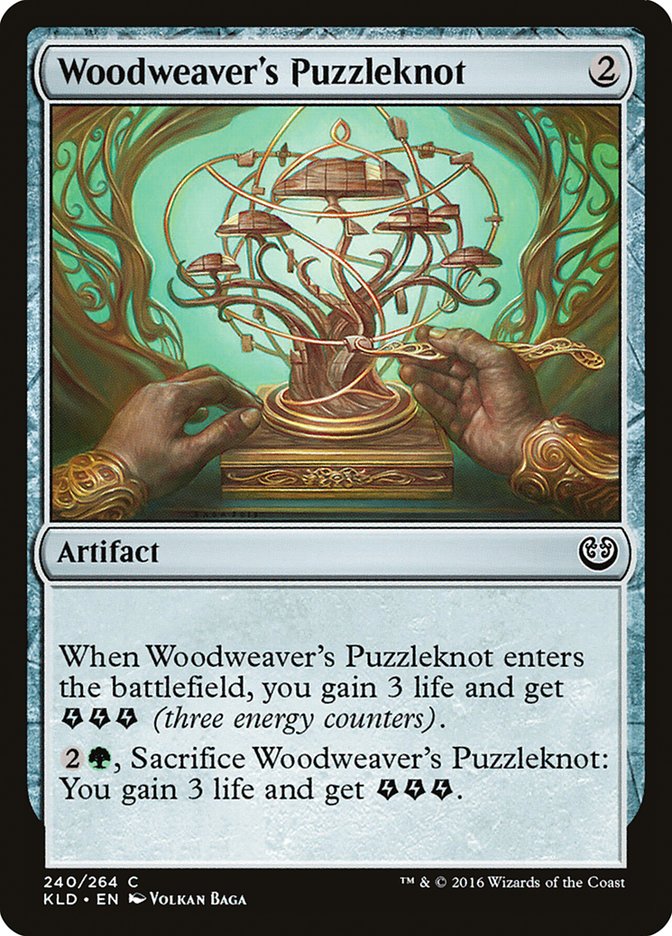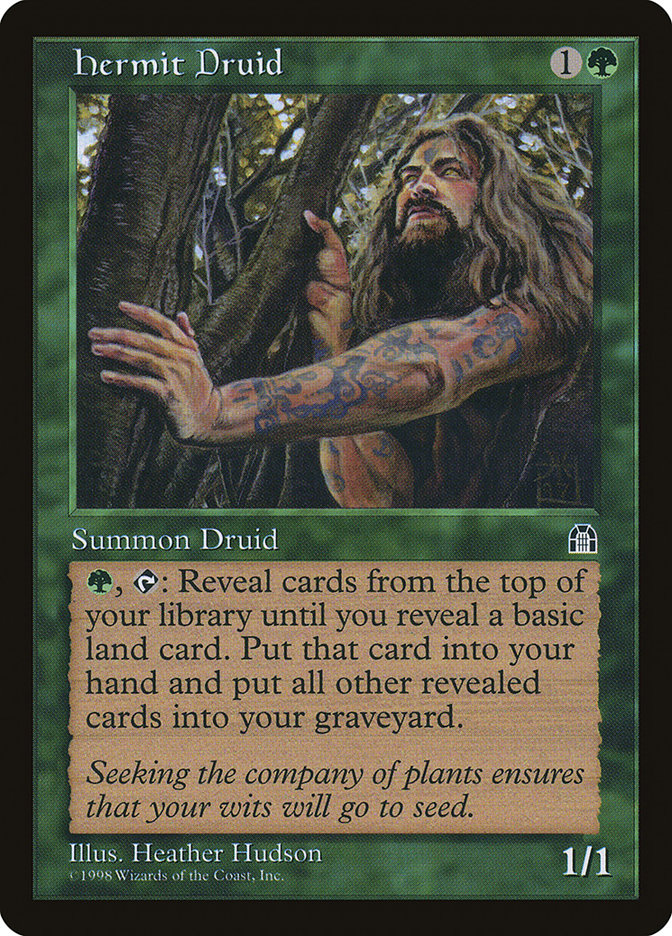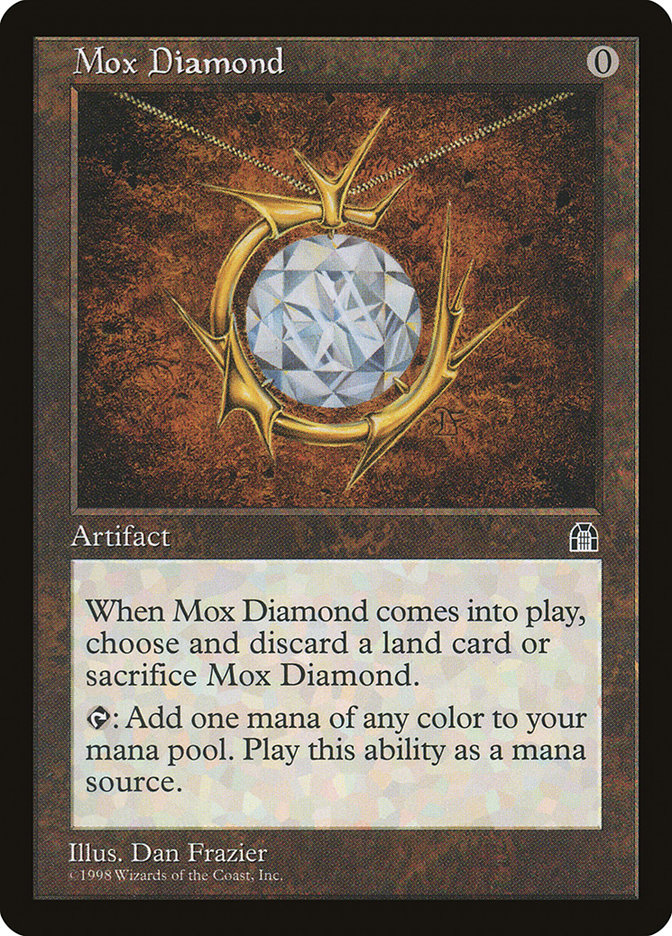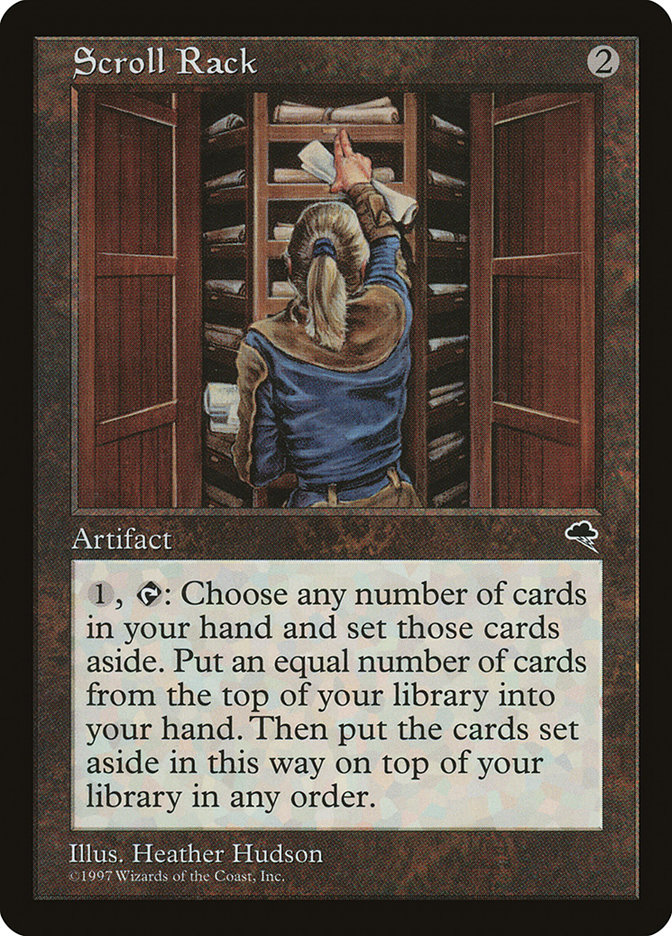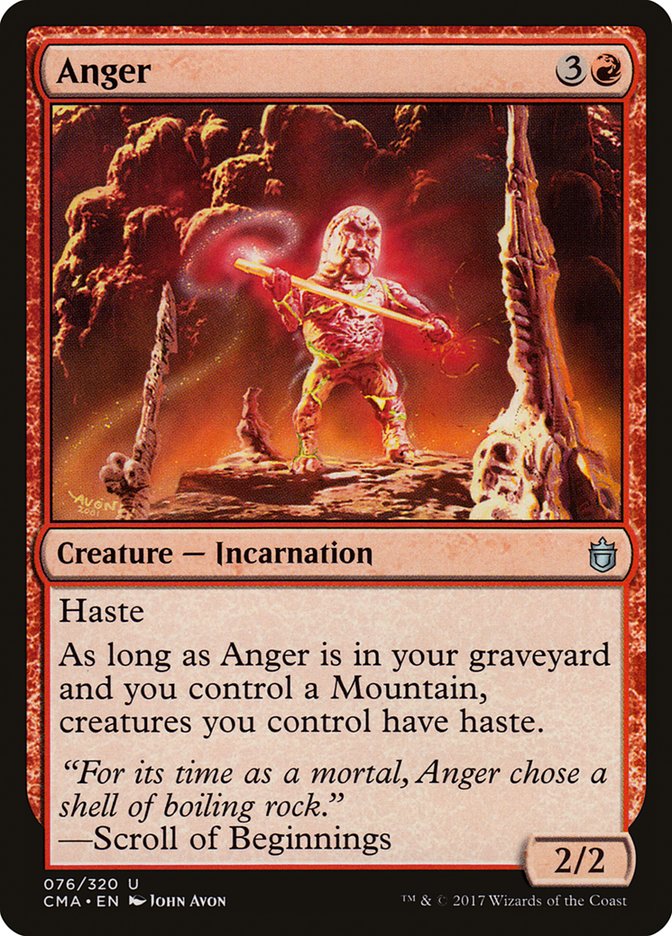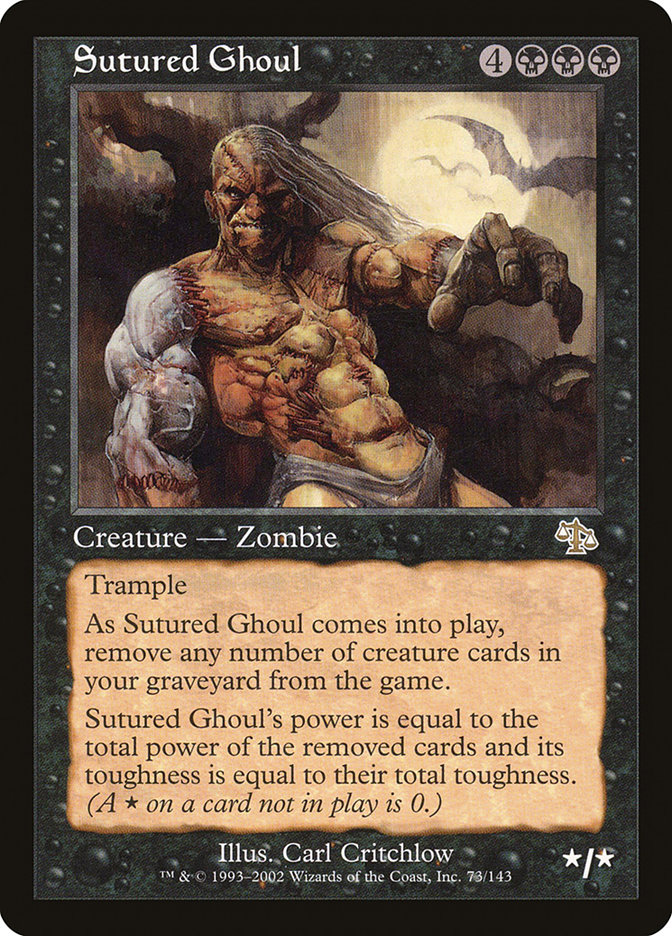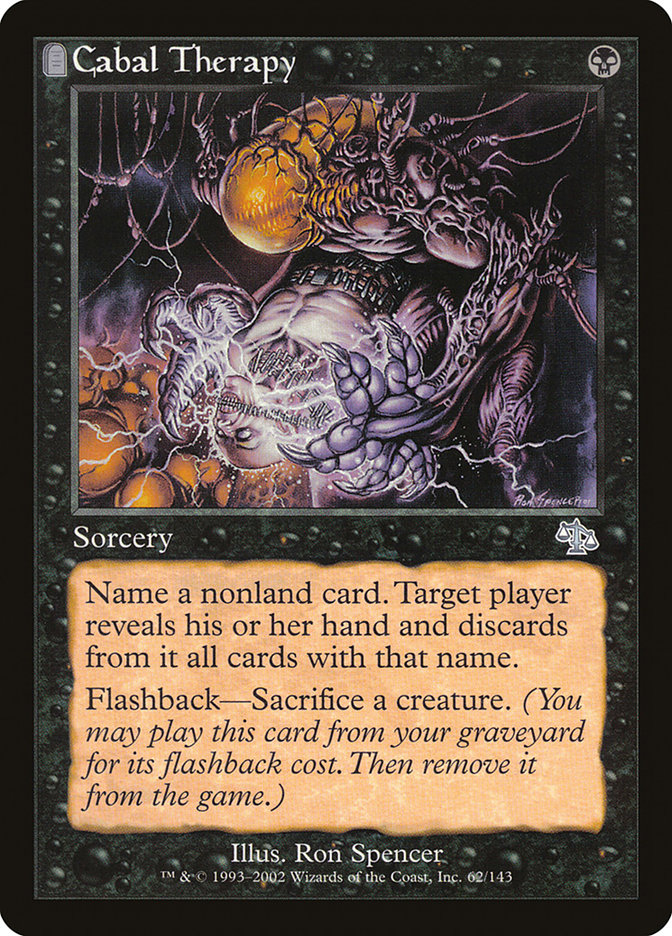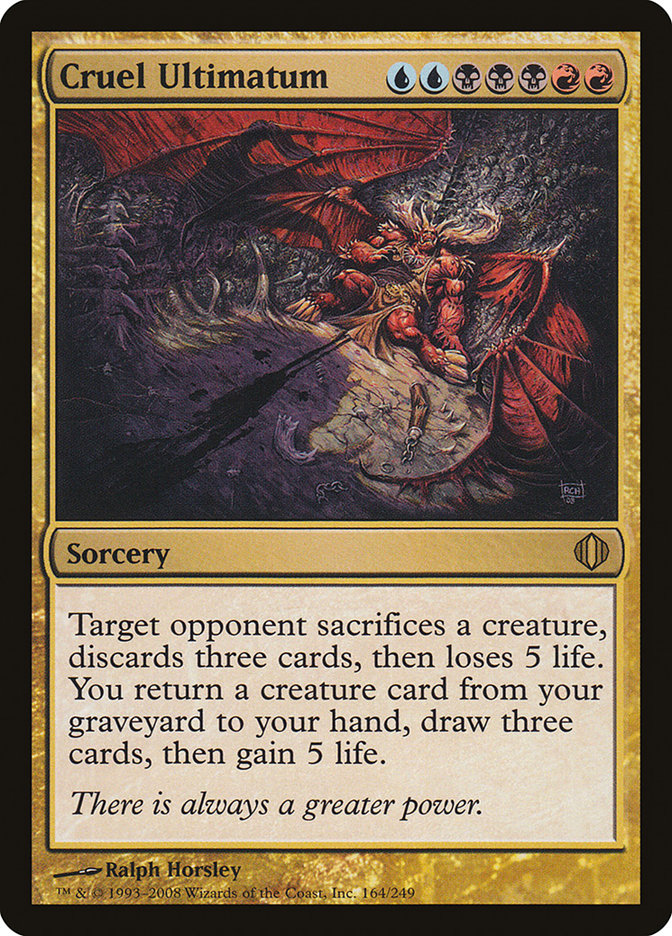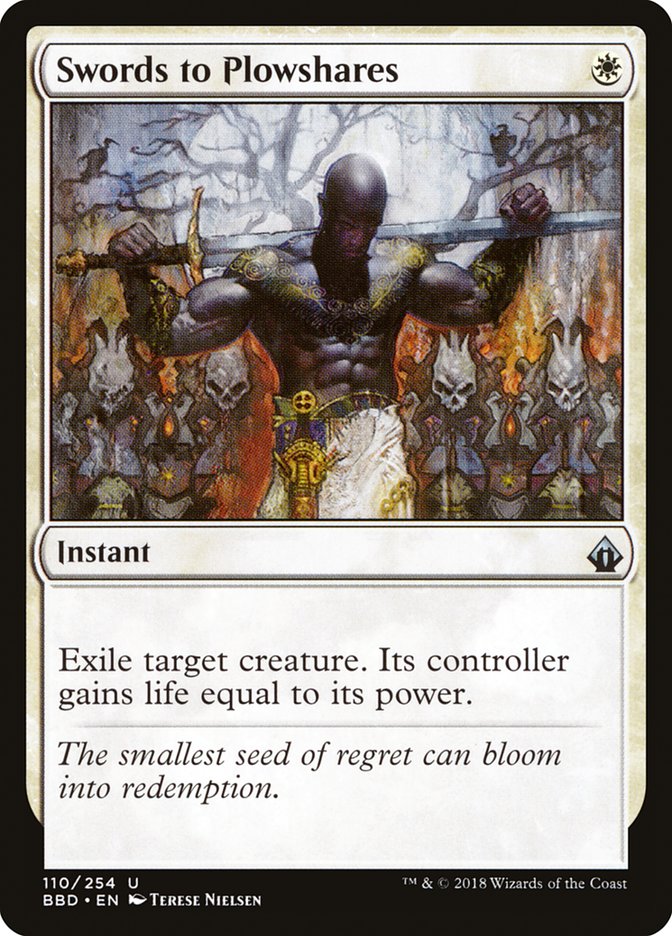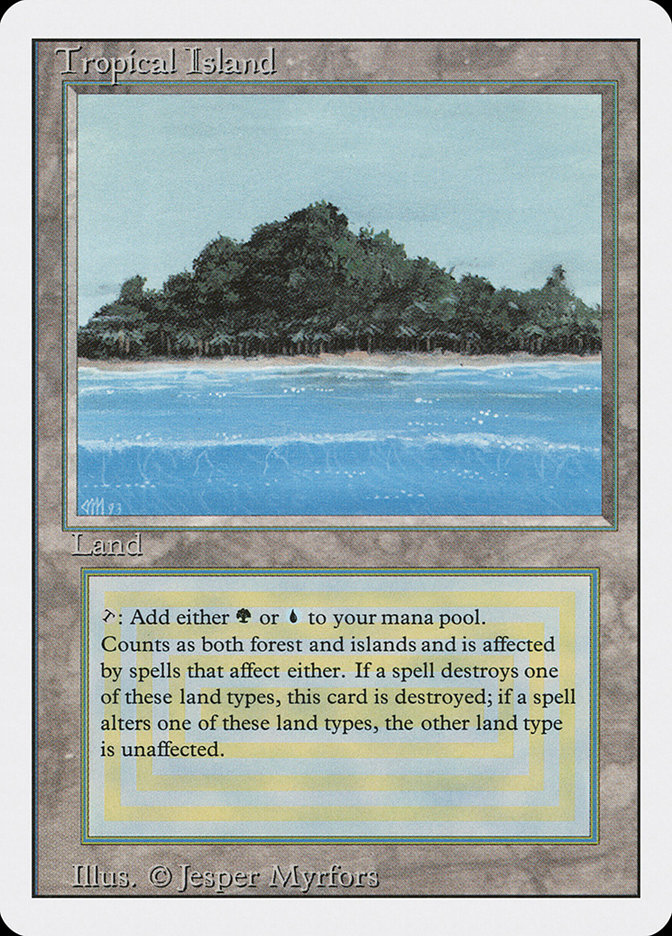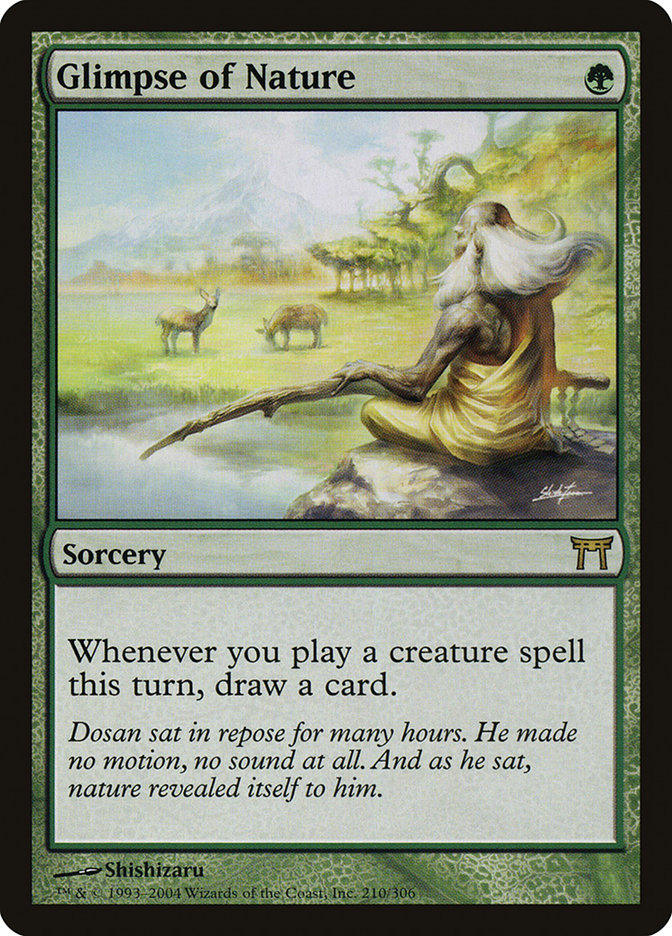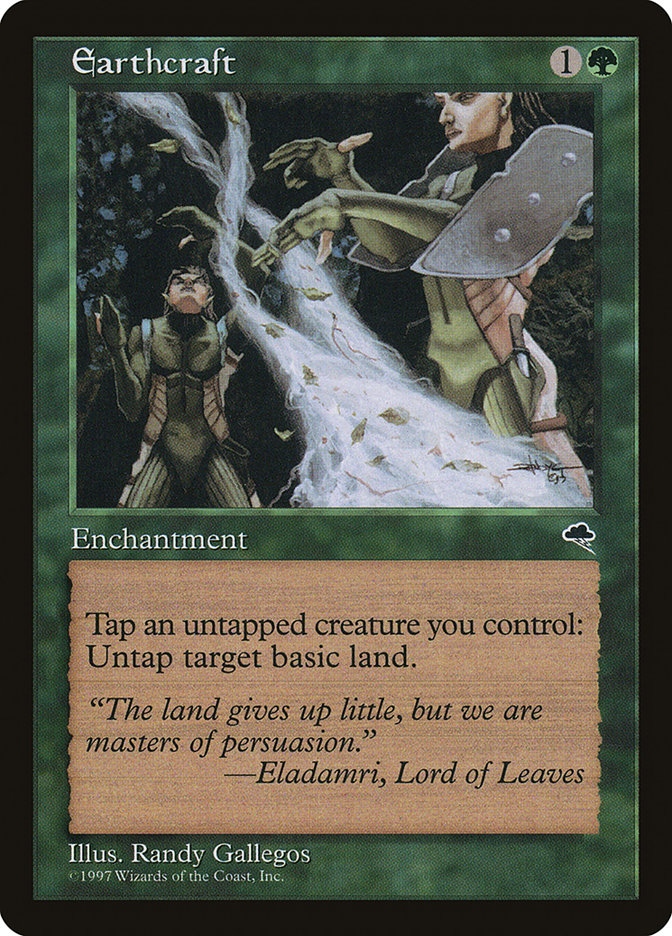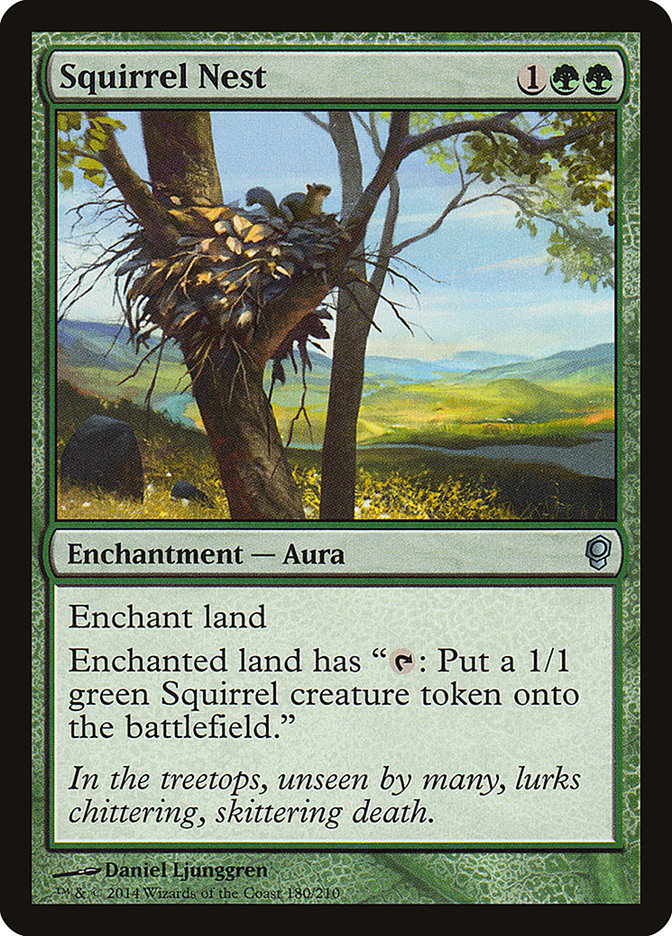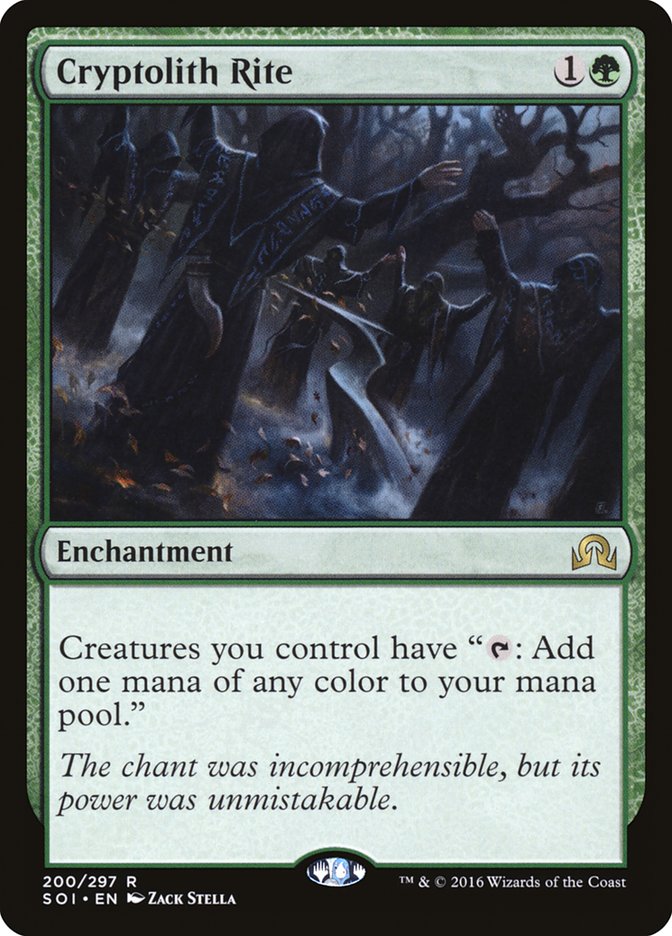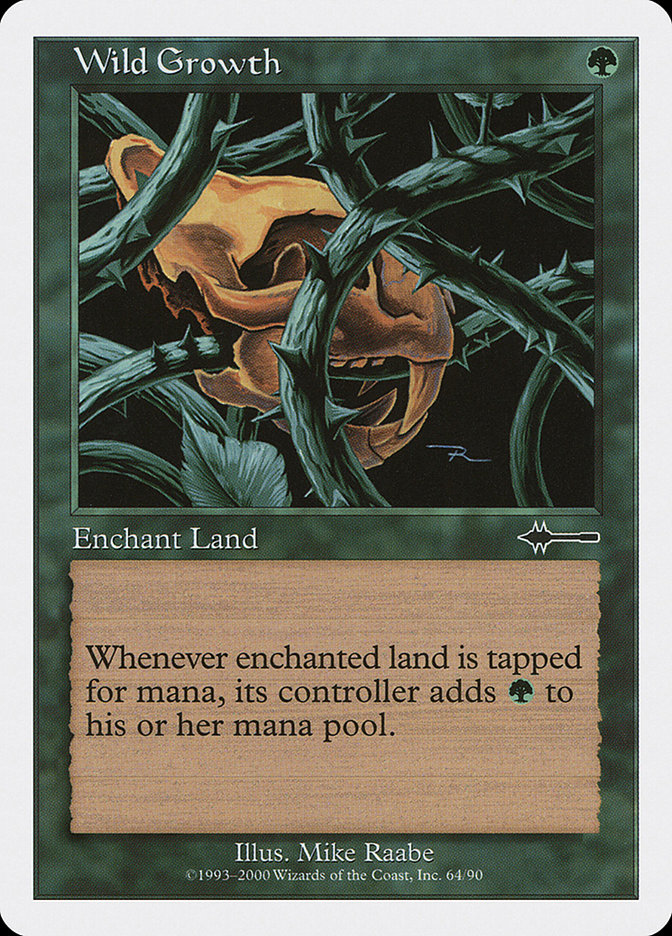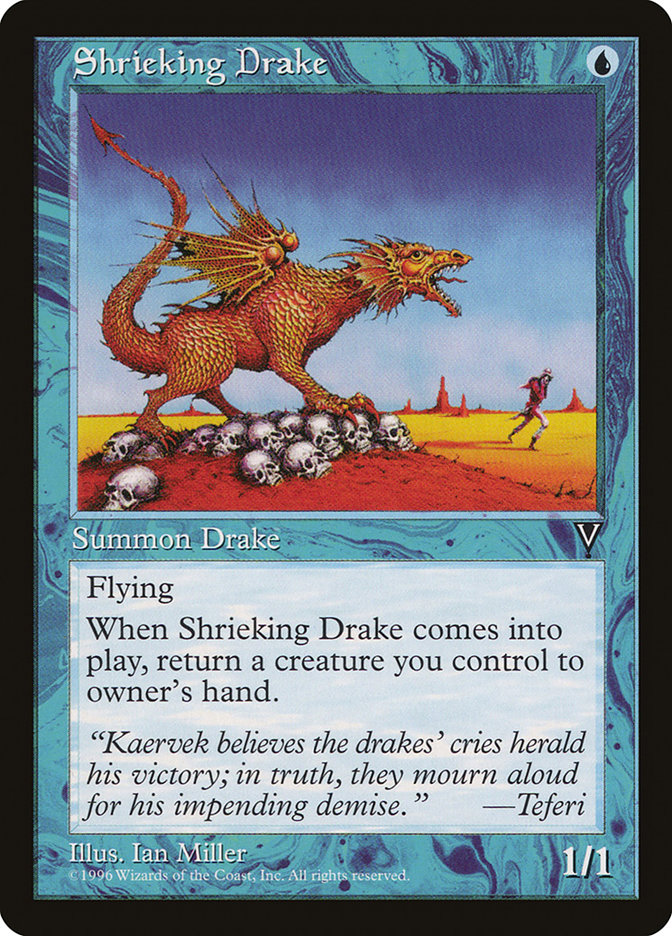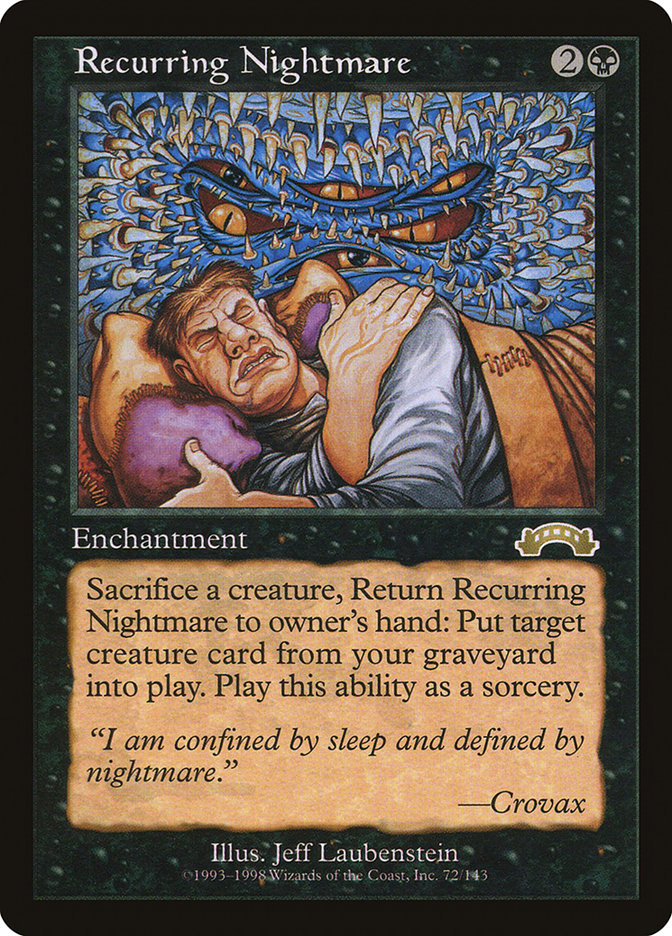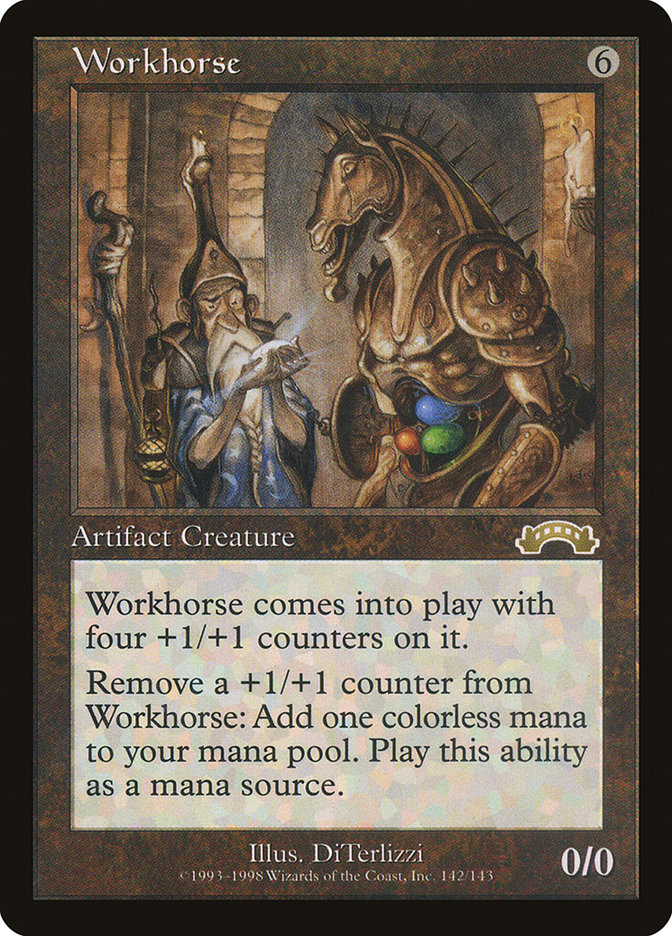Regrowth, Sylvan Library, Crop Rotation, Plow Under, and Rofellos, Llanowar
Emissary can’t even crack the top 25 green cards of all-time?
What a time to be alive…
#10: Eureka
While Eureka has never really enjoyed much tournament success, that’s in
large part due to only being printed in 1994 and never being legal during a
time period in which creatures costing more than four were remotely good.
While the card is merely a fringe curiosity in today’s Legacy format,
there’s no question that it would be outrageously busted in Modern and most
Standard formats we see these days. It’s basically Hypergenesis and a
cascade card rolled into one, and without the same deckbuilding
restrictions!
Here’s an example of what a Eureka deck might look like nowadays:
Creatures (13)
Planeswalkers (2)
Lands (17)
Spells (29)

Even setting aside
the Reserved List
, Eureka would be pretty near the top of the list of cards never getting
reprinted in a Standard-legal set. The only thing the card does is play
everything for free in one turn. There’s basically no redeeming qualities
to the card’s impact on the game before and after it’s played, and
generally, the game is effectively over upon resolution.
If they ever reprinted it, it would be sort of like Aetherworks Marvel,
except without the energy requirements.
#9: Hermit Druid
Hermit Druid was such a sweet card when all we did with it was
keep hitting our land drops in our Living Death decks, all the while
accumulating material in the graveyard to ensure Living Death was
game-winning.
Creatures (19)
- 1 Spike Weaver
- 1 Verdant Force
- 3 Tradewind Rider
- 4 Wall of Blossoms
- 1 Shard Phoenix
- 1 Coffin Queen
- 1 Spike Feeder
- 4 Hermit Druid
- 1 Stronghold Assassin
- 1 Thrull Surgeon
- 1 Anarchist
Lands (16)
Spells (25)

The card was extremely powerful, to be sure, but there was a lot of risk
analysis that went along with the card, too. The synergy with Mox Diamond
and Scroll Rack was what really pushed the card over the edge, however.
Hermit Druid was relatively forgotten about in Standard, thanks to the
extremely dysfunctional and broken in half Urza Block. However,
just over two years later, Bob Maher top 8’ed Pro Tour Houston with a
Dutch-designed Hermit Druid deck that would quickly ensure the card’s
banning in basically every non-Vintage format from here on out.
Creatures (12)
Lands (22)
Spells (26)
- 4 Vampiric Tutor
- 4 Duress
- 2 Reanimate
- 1 Mountain
- 4 Exhume
- 4 Entomb
- 2 Cabal Therapy
- 1 Krosan Reclamation
- 4 Mox Diamond
Sideboard

The Angry Hermit: Part 2 (not to be confused with
Angry Hermit: Part 1
) is built to exploit Hermit Druid needing to keep going until you hit a basic land.
But, what if you don’t play any basic lands?
Unintended interactions have a tendency to generate emergent gameplay.
However, some interactions lead to such a fundamental breakdown of the game
engine that we would consider the game to be degenerate; the game has truly
degenerated into a strange and uninteresting exercise, alien to the
experience originally sought. Sure, it could be extremely interesting for a
couple games, until you “get the joke.” After that, however, there’s really
not a lot to think about.
Simply activate Hermit Druid (potentially with haste, thanks to Anger) and
flip your whole deck. Then reanimate a Sutured Ghoul and attack
immediately, thanks to that same Anger. Even if you don’t have a
reanimation spell, you are assured of flipping Krosan Reclamation, which
can then give you a library consisting of two reanimation spells.
You’re even guaranteed to flip Cabal Therapy, letting you cash in your
Hermit Druid to make sure the coast is clear!
#8: Tarmogoyf
My pick for the best green creature of all-time, Tarmogoyf is a
cross-format superstar. You could write
a book
about all of the good Tarmogoyf decks, but if we’re going to pick one, we
might as well pick a Pro Tour winner.
Creatures (13)
Lands (21)
Spells (26)

This four-color Counterbalance deck was my attempt to try to jam as many of
the best cards in the format as I could into a single deck. I knew I was
going to be unable to attend that Pro Tour, but it was pretty rad to watch
one of the guys Luis Scott-Vargas shared my list with go on to win the
whole thing.
While that wasn’t the last time I’d have that experience, I certainly
didn’t get left out of the action. Everyone remembers the Mono-Red
Dragonstorm deck Mark Herberholz, Gabriel Nassif, and I ran the tables with
later that year; however, that tournament also featured five rounds of
Legacy, ending day 2 and deciding who would make the final cut. There, I
played basically the same deck as the Valencia deck above, except with all
the Legacy staples I could, such as:
#7: Glimpse of Nature
Speaking of Luis Scott-Vargas, number seven on our list enjoyed its first
extreme breakthrough in the hands of LSV, in his first of many, many top Pro Tour finishes.
Creatures (32)
- 4 Llanowar Elves
- 4 Wirewood Symbiote
- 1 Eternal Witness
- 2 Viridian Shaman
- 4 Elves of Deep Shadow
- 4 Birchlore Rangers
- 4 Heritage Druid
- 4 Nettle Sentinel
- 1 Regal Force
- 4 Elvish Visionary
Lands (16)
Spells (12)
Sideboard

In the days leading up to the tournament, buzz began to grow around the Elf
Combo deck that took an engine first unveiled by Hall of Famer Alan Comer
and ratcheted it up to 11.
Yeah, it turns out, drawing a card for every creature you play is kind of a
big game. I can’t help but wonder, though, was Glimpse of Nature really the problem? I mean, the difference between a two-cost
spell and a one-cost spell can be all the difference in the world, but how
sure are we that it was Glimpse doing the breaking…?
I think there’s a good case to be made for Heritage Druid being the guilty
party, but the reason I still think its Glimpse of Nature’s fault is how
there are fifteen other mana creatures that could be a part of a busted
Glimpse of Nature deck, while Glimpse of Nature and Skullclamp are
basically the only two cards that have made Elves degenerate (and I guess maybe Gaea’s Cradle, if we’re being very generous). The mana
creatures are just so core to green’s identity, whereas the efficiency of
card draw possibly from Glimpse of Nature shouldn’t belong to anyone.
#6: Earthcraft
Earthcraft is most commonly thought of alongside Squirrel Nest:
This combination creates an extremely cheap and efficient loop that is just
one example of how many normal cards break in half when Earthcraft is in
the mix, despite how similar it is to some modern day cards, such as
Cryptolith Rite.
Earthcraft has long been banned out of basically everything, including
Legacy, thanks to interactions like:
Turn 1: Wild Growth
Turn 2: Earthcraft, then drop Shrieking Drake and respond to its trigger by
tapping it to untap the land with Wild Growth on it.
Still, there were days long ago when Earthcraft was still legal, and one of
my favorite Earthcraft decks was the surprise Block Constructed infinite
combo deck Horsecraft:
Creatures (17)
- 1 Mogg Fanatic
- 3 Spike Weaver
- 4 Wall of Blossoms
- 2 Spike Feeder
- 1 Hermit Druid
- 1 Stronghold Assassin
- 1 Spike Breeder
- 2 Workhorse
- 2 Mindless Automaton
Lands (10)
- 10 Swamp
Spells (33)

Despite having just Tempest, Stronghold, and Exodus to get cards from, Erik Lauer and the rest of Team CMU
managed to find an infinite combo deck in a format that wasn’t expecting
one. On the surface, Horsecraft looked like just another Survival of the
Fittest/Recurring Nightmare deck, albeit with a few slightly exotic card choices.
Earthcraft + Recurring Nightmare + two Workhorses could make infinite
colorless mana, letting you cycle through your whole deck with Mindless
Automaton. You could also loop plenty of other things, like Spike Feeder,
Wall of Blossoms, and Spike Breeder, and there were several other loops
possible, such as:

And…

Nowadays, people lose their minds every time a card is banned, but in March
of 2000, half a dozen cards were banned in Standard (right after a wave of
bannings in December), which was quickly followed up with the first ever
“Emergency Retroactive Banning” of Memory Jar just two weeks later, thanks
to Erik Lauer, Randy Buehler, and the rest of Team CMU, who I would
estimate is the team that has been responsible for getting the most cards
banned in Magic, thanks to their broken decks.
What was Wizards of the Coast to do?
Maybe we should ask some of my Team CMU cohorts:
- Aaron Forsythe
- Erik Lauer
- Mike Turian
- Randy Buehler
- Brian Schneider
- Paul Sottosanti
Wait a minute…


